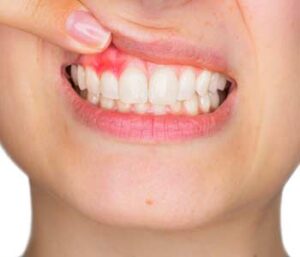Gum disease is an infection of the gums with oral bacteria, resulting in inflammation and irritation of the gum tissue. Most adults will suffer from gum disease at some point in their lives. In its early stages, it is easy to treat with basic oral hygiene practices, but as it worsens, it becomes harder to treat and may lead to more serious oral health problems, like loose and missing teeth. It’s therefore important to be on the lookout for signs of gum disease so that if they do appear, you can seek treatment as soon as possible. As with most oral health ailments, gum disease is easier to prevent than it is to treat.
Gum Disease Treatment
How are gum diseases treated?
- Gum diseases are treated in a variety of ways depending on the stage of the disease, how you may have responded to earlier treatments, and your overall health.
- After a thorough periodontal evaluation, recommendations for treatment range from non-surgical therapies to surgical procedures. Non-surgical approaches control the growth of bacteria. Surgical procedures restore the tissues surrounding and supporting the teeth.

What are the symptoms of gum disease?
Gum disease occurs in several stages. Early-stage gum disease is known as gingivitis, a term that simply means “inflammation of the gums.” Later-stage gum disease is known as “periodontitis,” a term that refers to inflammation of the periodontal ligaments, which are connective tissues that anchor your teeth into your jaw bone. The symptoms of gum disease start off rather minor but become harder to overlook as the condition worsens. Here are the hallmark symptoms of both gingivitis and periodontitis.
Gingivitis Symptoms: Signs of early-stage gum disease include swelling, redness, and sensitivity in the gums. You may notice some bleeding after brushing or flossing. Your gums may also feel sore if you chew something overly tough or crunchy. Many patients with gingivitis have bad breath that does not go away with brushing, flossing, and the use of mouthwash.
Periodontitis Symptoms: As gum disease worsens, you may begin to notice pockets forming between your teeth and gums. Your teeth may start to feel like they are loose in their sockets. Bleeding will worsen, and it may look like your teeth are becoming longer as your gums recede, exposing a larger portion of the tooth roots. Most people with periodontitis notice that their teeth become very sensitive to heat, cold, and pressure. This is because the nerves in the tooth roots are closer to the surface, and when they are exposed by receding gums, they react strongly to stimuli.
What are the causes of gum disease?
Anyone can develop gum disease. It is seen in young children, teens, young adults, and older adults alike. However, some people are at an increased risk of gum diseases compared to others. Here are some of the most common risk factors for gum disease.
Smoking: Smoking dries out the mouth, which allows oral bacteria to proliferate, increasing the risk of gum disease.
Certain Medications: Antidepressants, steroids, and pain relievers sometimes reduce saliva production, which increases the risk of gum disease.
Diabetes: This disease decreases the body’s ability to fight off infections such as gum disease.
Hormonal Changes: Women are more likely to develop gum disease after menopause.
Advanced Age: Gum disease becomes more common as you age. This may be tied to an increased risk of dry mouth as you age, hormonal changes, or a lack of proper oral hygiene.
What is the process like?
If you develop gum disease, it is very important to seek prompt treatment. Left untreated, gum disease can lead to missing teeth. Non-Surgical and Surgical treatments are available depending on how severe gum disease is. Options will be discussed in your consultation.

